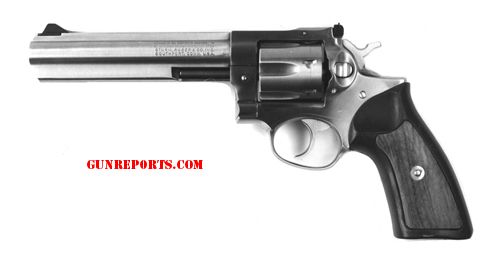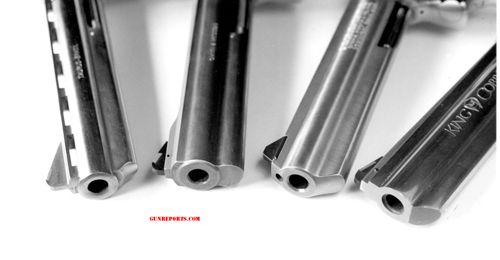Courtesy Gun Tests

Courtesy Gun Tests

Some time back on these pages we gave you the results of a test of three .357 Magnum double-action revolvers with four-inch barrels. However, our gun stores tell us that, because so many shooters dont read Gun Tests, folks continually come in and ask which brand of .357 they ought to buy.
We chose the Ruger GP100 as one of the test guns. It had a semi-matte gray appearance, black rubber grips, and adjustable sights featuring a white-outlined black rear sight. The sight radius of the revolver was 7.5 inches. There was no provision for mounting a scope.
The Ruger GP100s grips were black rubber without grooves, but the sides had decorative inserts of brown wood-like material (which some actually found attractive) that give the gun a distinctive look. The grips felt just great in both aimed single-action fire and in rapid-fire double action. Recoil was spread over a large area of the hand and that made for good shooting comfort, even with the heaviest loads.
The controls all functioned well and positively, and we found this to be a pleasant gun to handle and shoot. The trigger was well curved and smooth, and the double-action cycling was just slightly heavier than that of the Smith & Wesson. Trigger movement was even and smooth enough to permit good accuracy when shooting it slowly in the double-action mode. Because it sat lower in the hand than the S&W, the muzzle didnt rise as high. Thus, it allowed faster follow-up shots.
The Ruger GP100 was equipped with a front-end latch that secured the cylinder at the crane. After firing about 50 rounds through each gun, we found some wear marks. The Rugers hammer was noticeably scuffed on the left side, which showed that it was rubbing against the frame.
The single-action trigger pull was quite crisp with no apparent creep. The Ruger GP100 had a 0.006-inch barrel-to-cylinder gap and a pull of 5.5 pounds.
We measured the forcing cone diameter as 0.375 inch for the Ruger. Note that the Ruger felt extremely tight with the hammer back, there being no movement to the cylinder whatever. It was, in fact, the tightest feeling gun of this test in this regard. Nevertheless, it spit the most material back at us. We mention this because so many shooters try to evaluate a revolvers qualities by how tight the cylinder feels, but the real proof is in the shooting.
Overall group size averages with the hot and popular Federal 125-grain JHP ammo were: Ruger, 2.1 inches. The Ruger seemed to like the 158-grain lead semi-wadcutter bullets of our Black Hills test ammunition. If we threw out one shot from each of the Rugers groups, its accuracy results would have been stunning with this ammunition.
There were no mechanical problems. None of these guns had ejector rod throws that were long enough to fully remove fired cases from the cylinders, but that didnt matter. Also, we found no binding in double-action mode, even after firing many rounds with no cleaning. This was commendable.
The Ruger GP100 felt really good in the double-action mode, either fast or slow fire. We were able to make relatively good hits on target at long range, not exactly the realm of the double-action system. Up close and personal, the Ruger fired shots smoothly and reliably as fast as we could stroke the trigger, and it was by no means clean at this point in testing. With some handguns, carbon and unburnt gun powder will often tie up the double-action mechanism so that repeated rapid-fire shooting becomes difficult, if not impossible. This wasnt so with the Ruger. It kept on ticking.
























